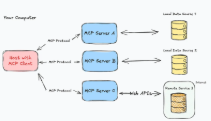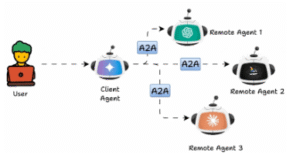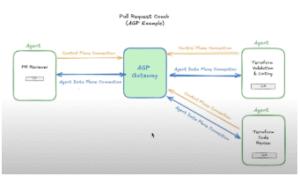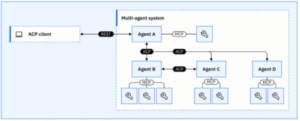The landscape of AI agent communication has evolved rapidly, with multiple protocols emerging to address different architectural needs and use cases. As organizations increasingly deploy multi-agent systems, understanding the distinctions between Model Context Protocol (MCP), Agent-to-Agent (A2A), Agent Gateway Protocol (AGP), and Agent Communication Protocol (ACP) becomes crucial for making informed architectural decisions.
Each protocol represents a different approach to solving the fundamental challenge of how AI agents should communicate, coordinate, and share resources. While they may appear similar on the surface, their underlying philosophies, architectural patterns, and optimal use cases differ significantly. This analysis will explore these differences and help you determine which protocol best fits your specific requirements.
Understanding Model Context Protocol (MCP)
Model Context Protocol represents a standardized approach to connecting AI models with external data sources and tools. MCP focuses primarily on enabling AI assistants and language models to access contextual information from various sources in a secure and standardized manner.
The protocol emphasizes simplicity and security, providing a clear separation between the AI host and the data sources it needs to access. MCP servers act as intermediaries that expose specific capabilities to AI clients while maintaining strict control over data access and operations.

Figure 1: MCP Architecture showing Host with MCP client connecting to multiple MCP servers for local data sources and remote services
MCP’s architecture demonstrates its strength in scenarios where you need to connect AI models to diverse data sources. The protocol excels in environments where data security, access control, and standardized interfaces are paramount. Each MCP server can be independently developed and maintained, providing excellent modularity and separation of concerns.
The protocol’s design makes it particularly suitable for enterprise environments where AI assistants need controlled access to internal systems, databases, and APIs. The standardized interface ensures that new data sources can be added without modifying the AI client, promoting scalability and maintainability.
Exploring Agent-to-Agent (A2A) Communication
Agent-to-Agent protocol takes a fundamentally different approach, focusing on direct communication between autonomous AI agents. A2A enables agents to collaborate, share information, and coordinate actions without requiring centralized coordination mechanisms.
This peer-to-peer approach allows for more dynamic and flexible interactions between agents, where each agent can maintain its own capabilities, knowledge, and decision-making processes. The protocol supports scenarios where agents need to work together on complex tasks that require distributed problem-solving.

Figure 2: A2A architecture showing direct agent-to-agent communication with a client agent coordinating multiple remote agents
The A2A pattern shown in the diagram illustrates how a client agent can orchestrate multiple remote agents to accomplish complex tasks. This distributed approach offers several advantages, including fault tolerance, scalability, and the ability to leverage specialized agents for specific domains or tasks.
A2A communication excels in scenarios where you need autonomous agents to collaborate dynamically, such as in distributed problem-solving, multi-domain expertise integration, or when building resilient systems that can continue operating even if individual agents become unavailable.
Analyzing Agent Gateway Protocol (AGP)
Agent Gateway Protocol introduces a centralized coordination model through a gateway that manages communication between multiple agents. AGP combines the benefits of centralized coordination with the flexibility of distributed agent deployment.
The gateway serves as both a communication hub and a control plane, enabling sophisticated orchestration patterns while maintaining clear separation between different types of connections. This architecture supports complex workflows that require coordination between multiple specialized agents.

Figure 3: AGP example showing Pull Request Coach with centralized gateway managing control plane and data plane connections to specialized agents
The Pull Request Coach example demonstrates AGP’s strength in workflow orchestration scenarios. The gateway manages both control plane connections for coordination and agent data plane connections for actual work execution. This separation allows for sophisticated coordination patterns while maintaining performance for data-intensive operations.
AGP is particularly well-suited for scenarios requiring complex workflow orchestration, where multiple specialized agents need to work together in a coordinated manner. The centralized gateway provides opportunities for monitoring, logging, and policy enforcement across the entire agent ecosystem.
Examining Agent Communication Protocol (ACP)
Agent Communication Protocol represents a hybrid approach that combines elements of both centralized and distributed communication patterns. ACP provides structured communication mechanisms while allowing for flexible topologies and interaction patterns.
The protocol supports hierarchical agent organizations where agents can communicate both horizontally with peers and vertically through structured relationships. This flexibility enables complex organizational patterns that mirror real-world collaborative structures.

Figure 4: ACP architecture showing hierarchical agent communication with REST interfaces and MCP tool connections
The ACP architecture demonstrates how agents can be organized in hierarchical structures while maintaining individual tool access through MCP connections. This hybrid approach allows each agent to maintain its own capabilities while participating in larger collaborative structures.
ACP excels in enterprise scenarios where you need to model complex organizational structures or hierarchical decision-making processes. The protocol’s flexibility supports various communication patterns while maintaining clear boundaries and access controls.
Protocol Comparison Matrix
Understanding the key differences between these protocols requires examining them across multiple dimensions. The following comprehensive comparison highlights how each protocol addresses different architectural concerns and use case requirements.
| Aspect | MCP | A2A | AGP | ACP |
| Architecture Pattern | Client-Server with standardized interfaces | Peer-to-Peer distributed | Centralized Gateway Hub | Hierarchical with flexible topologies |
| Communication Model | Request-Response via MCP servers | Direct agent-to-agent messaging | Gateway-mediated routing | Mixed direct and hierarchical |
| Primary Focus | AI-to-data source connectivity | Autonomous agent collaboration | Workflow orchestration | Organizational structure modeling |
| Security Approach | Server-side access controls and authentication | Distributed peer authentication | Centralized gateway security | Flexible security models (centralized/distributed) |
| Scalability | High (independent server scaling) | Variable (depends on coordination complexity) | Limited by gateway capacity | High (flexible scaling patterns) |
| Performance | Predictable (data access latency) | Variable (parallel processing benefits) | Gateway-dependent | Topology-dependent |
| Implementation Complexity | Low (standardized, simple) | Medium-High (distributed coordination) | Medium (gateway design critical) | High (flexible but complex design) |
| Fault Tolerance | Server-level isolation | High (distributed resilience) | Single point of failure risk | Variable (depends on hierarchy design) |
| Monitoring & Control | Server-level monitoring | Distributed, harder to centralize | Centralized at gateway | Flexible monitoring patterns |
| Data Flow | Unidirectional (client requests data) | Bidirectional (collaborative exchange) | Multi-directional via gateway | Multi-pattern support |
| Agent Autonomy | Limited (data access only) | High (full autonomous operation) | Medium (gateway-coordinated) | Variable (hierarchy-dependent) |
| Protocol Maturity | Emerging standard | Experimental/Research | Industry implementations | Theoretical/Academic |
| Learning Curve | Low | Medium-High | Medium | High |
| Best Suited For | AI assistants, knowledge bases | Research, dynamic collaboration | Enterprise workflows | Complex organizations |
| Ecosystem Integration | Growing standardization | Custom implementations | Enterprise system integration | Academic/research environments |
| Resource Requirements | Low to Medium | Medium to High | Medium (plus gateway overhead) | Variable |
This comparison matrix reveals that each protocol serves distinct architectural needs. MCP’s simplicity and standardization make it ideal for straightforward AI-to-data scenarios, while A2A’s distributed nature suits dynamic collaborative environments. AGP provides strong centralized control for complex workflows, and ACP offers maximum flexibility for sophisticated organizational modeling.
Architectural Comparison and Trade-offs
When comparing these four protocols, several key architectural differences emerge. MCP prioritizes simplicity and security in AI-to-data connections, making it ideal for scenarios where AI assistants need controlled access to information sources. The protocol’s strength lies in its standardization and security model, but it’s primarily designed for data access rather than agent collaboration.
A2A focuses on peer-to-peer agent collaboration, offering maximum flexibility and autonomy. This approach excels in dynamic environments where agents need to adapt and collaborate without central coordination. However, it can become complex to manage and monitor as the number of agents increases.
AGP provides centralized coordination through a gateway architecture, offering excellent control and monitoring capabilities. This approach works well for complex workflows but introduces a potential single point of failure and requires careful gateway design to avoid bottlenecks.
ACP offers a hybrid approach that can adapt to various organizational structures. Its flexibility is both a strength and a potential weakness, as it requires more careful design decisions to avoid unnecessary complexity.
Performance and Scalability Considerations
Performance characteristics vary significantly between these protocols. MCP typically offers predictable performance for data access operations, with performance primarily determined by the underlying data sources and network latency. The protocol’s simplicity contributes to reliable performance characteristics.
A2A can achieve high performance through parallel processing and distributed load sharing. However, performance can become unpredictable as agent interactions become more complex, and coordination overhead may increase with the number of participating agents.
AGP performance depends heavily on gateway design and implementation. A well-designed gateway can provide excellent performance through efficient routing and connection pooling, but poor gateway design can create bottlenecks that affect the entire system.
ACP performance varies based on the chosen topology and communication patterns. The protocol’s flexibility allows for performance optimization through careful architectural choices, but this requires more sophisticated design and monitoring.
Security and Access Control Models
Security approaches differ significantly across these protocols. MCP implements security primarily through server-side access controls and authentication mechanisms. Each MCP server is responsible for validating requests and controlling access to its resources, providing clear security boundaries.
A2A security relies on peer-to-peer authentication and trust relationships between agents. This distributed approach can be more resilient but requires careful management of agent credentials and trust relationships.
AGP centralizes security enforcement at the gateway level, providing opportunities for consistent policy application and centralized monitoring. This approach simplifies security management but requires robust gateway security implementation.
ACP supports various security models depending on the chosen architecture, from centralized to distributed approaches. This flexibility allows for security models that match organizational requirements but requires careful security design.
Use Case Optimization and Best Practices
Different protocols excel in specific use cases. MCP is optimal for AI assistants that need to access diverse data sources, enterprise knowledge bases, or external APIs. The protocol’s standardization makes it excellent for building ecosystems of reusable data connectors.
A2A works best for scenarios requiring autonomous agent collaboration, distributed problem-solving, or resilient systems that need to continue operating despite individual agent failures. Research environments and dynamic task allocation scenarios benefit significantly from A2A approaches.
AGP excels in workflow orchestration scenarios, complex business processes, and situations requiring centralized monitoring and control. Enterprise automation and regulated industries often benefit from AGP’s centralized coordination model.
ACP is ideal for organizations that need flexible agent hierarchies, complex decision-making structures, or hybrid communication patterns. Large enterprises with diverse collaboration requirements often find ACP’s flexibility valuable.
Future Evolution and Ecosystem Integration
The evolution of these protocols reflects the maturing AI agent ecosystem. MCP’s focus on standardization positions it well for broad adoption in AI assistant platforms. Its simplicity and security focus make it likely to become a foundation protocol for AI-to-data connections.
A2A protocols are evolving to address scalability and coordination challenges while maintaining their autonomous nature. Future developments likely focus on improved discovery mechanisms and more sophisticated coordination patterns.
AGP development trends toward more intelligent gateways that can provide advanced orchestration, monitoring, and optimization capabilities. Integration with existing enterprise systems and improved scalability are key focus areas.
ACP evolution emphasizes improved tooling for managing complex agent hierarchies and better integration with existing communication protocols. The focus is on reducing complexity while maintaining flexibility.
Conclusion and Protocol Selection Guidelines
Selecting the appropriate protocol depends on your specific requirements, organizational structure, and technical constraints. MCP is the clear choice for AI assistants requiring standardized data access with strong security controls. Its simplicity and growing ecosystem make it ideal for most AI-to-data scenarios.
Choose A2A when you need autonomous agents that can collaborate dynamically without central coordination. This approach works best when you can accept the complexity of distributed coordination in exchange for flexibility and resilience.
AGP is optimal for complex workflows requiring centralized coordination and monitoring. Organizations with sophisticated business processes and strong governance requirements often benefit from AGP’s centralized approach.
ACP provides the most flexibility but requires the most careful design consideration. Choose ACP when your requirements don’t fit neatly into other protocol models or when you need to support diverse communication patterns within a single system.
The future of agent communication likely involves hybrid approaches that combine elements from multiple protocols. Understanding each protocol’s strengths and limitations enables better architectural decisions and more effective agent system design.